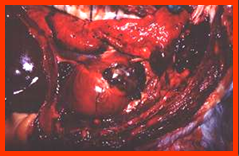By Dr. Bill Wigle, ADDL Pathologist
It is not uncommon that a dog with a history of sudden death is presented to ADDL for postmortem examination. A study in Canada reviewed laboratory findings over a ten year period and tabulated the most common causes of sudden unexpected death in dogs. A review of ADDL records was performed to determine if similar factors were involved in cases of sudden death in dogs that were submitted to this laboratory.
Records of canine necropsies performed at Purdue ADDL from January 1, 2007 through May 31, 2012, were reviewed. Over this period, a total of 1346 canine necropsy examinations were performed. Of these, 112 cases (8.3%) had a history of sudden death in which the animal was found dead, collapsed suddenly or was in a moribund state when found and died prior to receiving veterinary care. None of these dogs had a clinical history of ongoing disease at the time of death.
 The dogs ranged in age from 4 weeks to 14 years. The cardiovascular system was the most common system involved in sudden death cases. A total of 35 dogs (31%) had lesions suggesting that cardiovascular disease was the cause of sudden death. Lesions of myocardial degeneration, necrosis, hypertrophy, fibrosis or cardiac vascular disease were found in 11 dogs with an average age of 6.2 years. Seven dogs had hemangiosarcomas in the right atrium. Other cardiac neoplasms included two chemodectomas, a case of lymphosarcoma, a hematoma and an unidentified round cell tumor. The average age of dogs with cardiac neoplasia was 8.1 years. Seven dogs were diagnosed with cardiomyopathy. Average age of dogs with cardiomyopathy was 1.9 years. Two dogs had aortic stenosis and their average age was 7 months. Two cases of mitral valve degeneration were diagnosed in dogs aged 3 and 9 years. There were single cases of aortic rupture, heartworm disease and myocarditis.
The dogs ranged in age from 4 weeks to 14 years. The cardiovascular system was the most common system involved in sudden death cases. A total of 35 dogs (31%) had lesions suggesting that cardiovascular disease was the cause of sudden death. Lesions of myocardial degeneration, necrosis, hypertrophy, fibrosis or cardiac vascular disease were found in 11 dogs with an average age of 6.2 years. Seven dogs had hemangiosarcomas in the right atrium. Other cardiac neoplasms included two chemodectomas, a case of lymphosarcoma, a hematoma and an unidentified round cell tumor. The average age of dogs with cardiac neoplasia was 8.1 years. Seven dogs were diagnosed with cardiomyopathy. Average age of dogs with cardiomyopathy was 1.9 years. Two dogs had aortic stenosis and their average age was 7 months. Two cases of mitral valve degeneration were diagnosed in dogs aged 3 and 9 years. There were single cases of aortic rupture, heartworm disease and myocarditis.
 Gastrointestinal disease accounted for the cause of sudden death in 22 dogs (19.6%). Nine dogs had gastric dilatation and volvulus (GDV) and two others had marked gastric dilation. Average age was 5.2 years for this group but one dog with GDV was only 4 months old. Five dogs died acutely from parvoviral enteritis without showing clinical signs. These dogs averaged about 7 months of age. Intestinal volvulus was observed in 4 dogs with an average age of 3 years. Single cases of gastric infarct and intestinal foreign body were observed.
Gastrointestinal disease accounted for the cause of sudden death in 22 dogs (19.6%). Nine dogs had gastric dilatation and volvulus (GDV) and two others had marked gastric dilation. Average age was 5.2 years for this group but one dog with GDV was only 4 months old. Five dogs died acutely from parvoviral enteritis without showing clinical signs. These dogs averaged about 7 months of age. Intestinal volvulus was observed in 4 dogs with an average age of 3 years. Single cases of gastric infarct and intestinal foreign body were observed.
There were nine cases where trauma was determined to be the cause of death. The traumatic incident was not observed by the owners in any of these cases.
Although poisoning is often suspected in cases of “sudden death”, only 6 cases had chemical evidence supporting exposure to toxins. There were two cases of organophosphate exposure, two of ethylene glycol and one each of chocolate and diphacinone rodenticide poisoning.
Only five cases of sudden death were attributed to respiratory disease. Single cases of bacterial pneumonias were caused by Bordetella sp. and Pasteurella sp. and two cases were caused by Streptococcus sp. A single case of chylothorax was also diagnosed
Three cases involving the central nervous system included individual instances of encephalitis, nonsuppurative meningoencephalitis and hydrocephalus. Three young dogs ranging in age from 6 weeks to 3.5 months of age died of food aspiration and asphyxiation. Two cases of sudden death involved the urinary system and included individual cases of pyelonephritis and urethral obstruction. Two dogs with sudden death involved neoplasms other than in the heart. One had metastatic osteosarcoma and one had a splenic hemangiosarcoma that ruptured resulting in hemoabdomen. Individual cases of hemothorax, hemoabdomen and severe pulmonary hemorrhage were diagnosed. No underlying cause of the hemorrhage was determined in these cases. A single case of acute pancreatic necrosis causing sudden death was diagnosed over the study period.
There were 21 (21.5%) cases in which no cause of sudden death could be determined from the necropsy findings or additional laboratory testing.
Findings were in general agreement with the Canadian study. They found cardiovascular disease to be the most common cause of sudden death followed by toxicity, gastrointestinal disease, trauma and non-traumatic hemorrhage with incidences of 21.9, 16.6, 12.6 and 6.6% respectively.
Reference: Olsen TF and Allen AL: 2000. Causes of sudden and unexpected death in dogs: A 10-year retrospective study. Can Vet J 41:873-875.